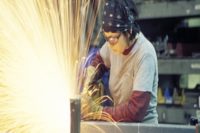Manufacturing covers an incredibly broad range of industries and products. However, businesses in this sector all have one thing in common: the need to protect their employees and equipment.
ESG means a lot more than a company’s individual environmental, social, and governance frameworks – it forms a central pillar around which operations must be built. At the core of this pillar is reducing the hazards that employees might be exposed to, and often, the biggest of these hazards comes in the form of air pollution.
Employers have a duty of care to protect the health of the people who work for them. The exact regulations may differ around the world, but most are generally similar: ensuring, as far as is practicable, the health, safety, and welfare of employees. Dangerous gases can pose major health threats to employees, the environment, and vital equipment alike, and the list of pollutants found in the manufacturing sector is extensive. From CO2, ammonia, and chlorine to harmful particulates like black carbon and sulphates, when a leak occurs, businesses must act quickly to prevent potential disaster – or better yet, stop it from happening entirely through preventative maintenance.
Addressing this problem might seem easier said than done. The accidental nature of most gas leaks, and the fact that most gases are colorless and odorless, renders many almost impossible to detect without access to bespoke monitoring equipment. However, armed with the right information backed up by readily available technology, manufacturers can gain a clearer picture of their emissions, and start ensuring the wellbeing of those they employ.

Clearing the air
Working is one of the most dangerous things we do. Data from the World Health Organization and International Labour Organization shows 1.9 million people died from work-related injuries and illnesses in 2016.[1] Most of these were due to respiratory and cardiovascular conditions, with 450,000 recorded as chronic obstructive pulmonary disease. This is the same number that were connected to exposure to workplace air pollution caused by particulate matter, gases, and fumes.
Toxic substances like these are all too common in manufacturing. For example, in industries where sterilization and disinfection are common practices, gases like chlorine and hydrogen peroxide may be used to ensure products are suitably clean but are also toxic irritants linked to a range of adverse health effects. Volatile organic compounds (VOCs) are another common by-product produced as a side effect when manufacturing things like inks or petrochemicals, but are often flammable or explosive, and can damage health and the environment alike. Effects of exposure to VOCs may differ depending on the exact source substance but can range from irritation to cancer or even death.
At high concentrations, VOCs may present an explosion or combustion risk. In the U.S., health regulators advise that confined spaces with concentrations of flammable vapours at 10% of the lower explosive limit (LEL) should be considered hazardous. Even at lower concentrations, these spaces are not necessarily safe, and concentrations to be considered toxic are much lower still, making early identification and mitigation essential to safety.
This is not to mention the connection between air pollution and workplace accidents. Work-related accidents are linked to around 360,000 deaths worldwide per year, according to the World Health Organization.[2] Research has found that an increase in nitrogen dioxide levels by one standard deviation increases the chances of a workplace accident occurring by 45% compared with the average likelihood.[3] As well as personal suffering, conditions like this can have an impact on productivity: the U.S.’s National Safety Council estimates that work-related accidents cost the economy $44.8 billion in 2020.[4]
Aside from the obvious effects on employee wellbeing, the potential effects of failing to clear the air on businesses can be significant. In addition to the health consequences, organizations that fail in their responsibilities on health and safety could face everything from major fines, criminal prosecution, and brand damage. What’s more, they may end up losing ground in a competitive market. Investors frequently use ESG compliance to evaluate potential investments, and companies that are seen as uncaring about the environment or employee health and wellbeing could become a PR disaster and thus represent a dangerous investment.
Addressing this problem is critical to success against an ESG framework. However, without a foundation of accurate data, doing so will often prove impossible. Manufacturers must have a deep understanding of where and how gas leaks are occurring, or where particulate concentrations are high, so they can act on them. This in turn requires a network of intelligent sensing solutions.
Detection and monitoring
Gas detection equipment should be a central pillar to any health and safety strategy, especially in the manufacturing sector. Reliable measurement is instrumental to identifying and locating potential hazards. Without measuring a problem, it is impossible to know how serious it is, where it is occurring, and how to address it.
Solutions may take the form of personal, wearable detectors for protecting staff who face the most serious risks as part of their day-to-day duties. This includes those who might encounter equipment leaks or spills, or rogue emissions from valves and seals. Fixed VOC monitors can also be used to ensure workspaces do not approach harmful exposure levels, and issue alarms if they do.
However, foremost among these technologies in terms of effectiveness is laser absorption spectroscopy.
Laser absorption spectroscopy enables companies to detect trace amounts of gases in the air. Although it is widely used for environmental purposes, such as monitoring greenhouse gas emissions, it also has significant applications for workplace health and safety; namely, monitoring air pollution.
This technology relies on the unique characteristics of infrared light as it passes through a medium, using a sampling chamber and filter to block out certain wavelengths from reaching the detector. This detector measures the attenuation of those wavelengths that reach it to help it determine the exact concentrations of gas that are present. By changing the filter, operators can enable different wavelengths to reach the filter, meaning the equipment can be used to test for a wide range of gases.
Alongside performance, it’s just as important to ensure that gas detection sensors are reliable. Many sensors struggle with contamination or exposure to environmental conditions such as excess humidity. Modern gas analyser instruments overcome this issue by mounting a laser diode on a thermos-electric cooler, which tunes the laser’s wavelength to the specific one used by particular modules. Exploiting their high frequency resolution means the technology can detect more significant levels of interaction between gas molecules and light in the order of parts per billion. This also grants greater discrimination, eliminating the potential for false alarms.
Crucially, sensors such as this offer fast, accurate responses without the need for additional gases to operate and can continuously monitor for combustible gases or vapours within the LEL. They are also suitable for use in oxygen-deficient or enriched areas, require little calibration, and are immune to sensor poison, contamination, or corrosion.
Infrared filters enable this capability and more. As a result, they are increasingly being utilized in manufacturing businesses to help monitor and reduce gas emissions. With early detection made possible, operators can address leaks and other risks before they happen, taking preventative measures to protect employees and maintain compliance with regulations.
Non-dispersive infrared sensors that offer highly sensitive gas detection are critical to any effective health, safety, and welfare policy. More than that, they can help protect a company’s equipment, finances, and its very reputation. Although technology like this might seem like a small measure, in comparison with the potential consequences of inaction on air quality, the cost of any investment in detection technology is negligible.
[1] https://www.who.int/news/item/01-06-2023-launch-of-global-indicator-of-fatal-work-related-diseases-in-the-bulletin-of-the-world-health-organization#:~:text=WHO%20and%20the%20International%20Labour,died%20from%20work%2Drelated%20diseases.



